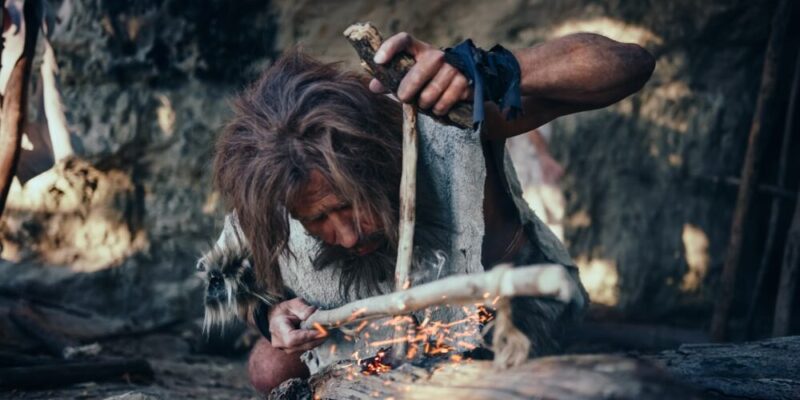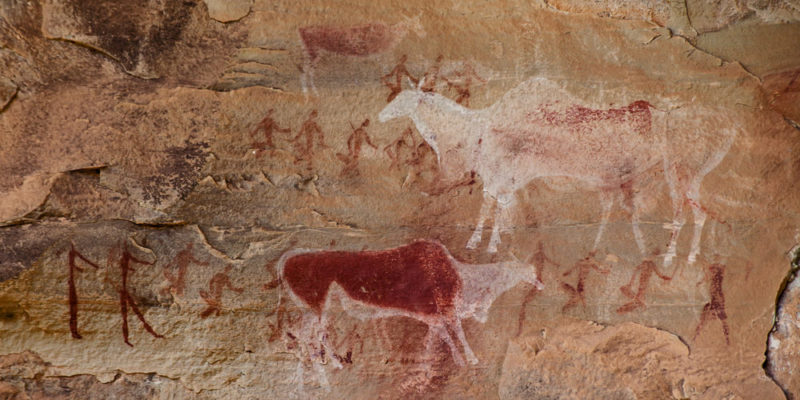We explain what prehistory is and its main characteristics. Also, what are its stages, prehistoric art and more.
What is prehistory or stone age?
Prehistory is the period from the appearance of the first hominids , about 2,500,000 years ago, to around 3000 BC. C . with the invention of writing in the region of lower Mesopotamia , at which point the history of mankind begins .It was an extensive era whose origin dates from the oldest vestiges of hunting tools made of stone, then continued with the evolution of the human species that learned to sow and practice agriculture, until the formation of towns and city-states with their own religious rules and rites, before the writing system was invented.
Prehistory is divided into two main stages:
- The Stone Age . It spanned between 2,500,000 and 4000 BC. The period is subdivided into the Paleolithic , Mesolithic and Neolithic .
- The Age of Metals . It spanned between 5000 and 1000 BC. C. The period is subdivided into the Copper Age, the Bronze Age and the Iron Age .
Characteristics of prehistory age
Prehistory was characterized by:
- The evolutionary leap of the hominids in which the first humans learned to control the fire they used, both to scare away wild animals and to warm themselves when they slept in caves.
- The evidences of the work of the stone by the humans . They consisted of tools, such as hand axes with a sharp edge or hand hammers without a handle.
- The development of primitive culture in which they practiced hunting, fishing and gathering.
- Humans were nomads , they moved in small groups and lived in caves.
Stages of prehistory
 Prehistory is divided into two general archaeological stages:
Prehistory is divided into two general archaeological stages:Stone Age. It consisted of the longest period of prehistory and included various evolutionary leaps, in addition to stonework. The period is subdivided into the following stages:
- The Paleolithic . It corresponds to the oldest stage of prehistory, from 2,500,000 to 35,000 BC. Its name comes from the Greek meaning "ancient stone." Among the most significant advances of this period are: the chipping stone work carried out by Homo habilis , which allowed him to create tools to hunt, and the control of fire carried out by Homo erectus that allowed him to defend himself from wild animals and settle in caves for a long time.
- The Mesolithic . It corresponds to the stage that goes from 10,000 to 6,000 BC. C. It was characterized by advances in polished stone work and by the change in lifestyle from nomadic to sedentary. This change was due to various factors, such as the end of the ice age and the gradual climate change in which temperatures were increasingly temperate, the control of fire to warm up that allowed them to withstand cold temperatures and the first planting practices of food.
- The Neolithic . It corresponds to the stage that goes from 6000 to 4000 BC. C. It was characterized by the work of the molded and polished stone, the advance in agricultural practices and the domestication of some animals that allowed the consolidation of the sedentary way of life and the settlements with a greater number of people.
The age of metals. It consisted of the second period of prehistory from 5000 to 1000 BC. C. and was characterized by the most significant changes in the evolution of human beings in prehistory. The period is subdivided into the following stages:
- The Copper Age. It corresponds to the stage that goes from 5000 to 3000 BC. C. in which the human invented the wheel and learned to work various metals , such as copper , to create tools to plow the earth, arrowheads and utensils.
- The Bronze Age . It corresponds to the stage that spanned from 3000 to 1500 BC. C. and stood out for the discovery of the metal alloy, after smelting copper with tin, which gave rise to bronze, a resistant metal. Tools were created for warfare, such as arrowheads. As larger towns and cities were formed , the wars for the struggle for territory and power increased.
- The Iron Age . It corresponds to the stage that spanned from 1500 to 550 BC. C. moment in which writing was invented and that begins the period of human history. It was characterized by the work of iron , a material that was even more resistant and that allowed expanding the production of elements, such as armaments and tools for working the land. Stone furnaces capable of withstanding high temperatures were used for smelting iron.
Prehistoric art

Prehistoric art was one of the first forms of communication , in addition to the gestures and sounds made by primitive humans. It turned out to be a way of recounting the customs and knowledge learned to subsequent generations, when writing did not yet exist.
The first type of art was cave painting, which consisted of representations of various animals, hunting scenes and silhouettes of human hands, made on the walls inside the caves. The most recognized evidences of cave paintings were found in the Altamira caves, in Spain, and the Lascaux caves, in France.
The first sculptures were made in the middle of the Paleolithic , in stone, bones and, later, in clay, and consisted of simple figures of animals and human women. It is estimated that they represented religious rites.
Towards the latter part of the prehistoric period, especially in the Metal Age, advances in artistic techniques were notorious, with metal sculptures and ornamental details.
The above content published at Collaborative Research Group is for informational and educational purposes only and has been developed by referring reliable sources and recommendations from technology experts. We do not have any contact with official entities nor do we intend to replace the information that they emit.
MA student of the TransAtlantic Masters program at UNC-Chapel Hill. Political Science with a focus on European Studies. Expressed ideas are open to revision. He not only covers Technical articles but also has skills in the fields of SEO, graphics, web development and coding. .
Leave a reply
Your email address will not be published. Required fields are marked *Recent post

Sport: What Is It, Types, Risks, Features, Characteristics and Examples

Dogs: Emergence, Features, Characteristics, Feeding and Breeds

Story: Definition, Elements, Structure, Features and Characteristics

